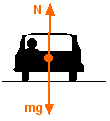The placement of the front (and rear) wings are definitely carefully regulated in the FIA technical regulations.
http://www.fia.com/resources/documents/ ... ATIONS.pdf
But there is "leverage" because the front wing downforce does exert a force vector downwards, and since the pivot is the front axle, a resulting force upwards at the rear of the car. But there are so many components of the car that exert downwards force. In fact, every part pretty well contributes to downforce.
But all those forces are definitely watched by the engineers, and they work very hard not only to achieve maximum downforce at minimal drag, but to "balance" the car. And of course, since they can manually adjust the front wings a bit during the race, this "balance" can be altered, slightly.
But the resulting forces aren't that great, they have minimal impact. I'm quite sure that if the front wing become detached you wouldn't see the rear wing push so hard down that the nose would rise, and the car somersault backwards. Theoratically possible, but we've all seen cars lose the noses and manage to get back to the pits without doing backflips.
- Login or Register
No account yet? Sign up






